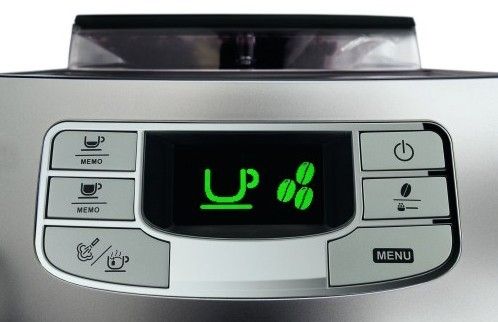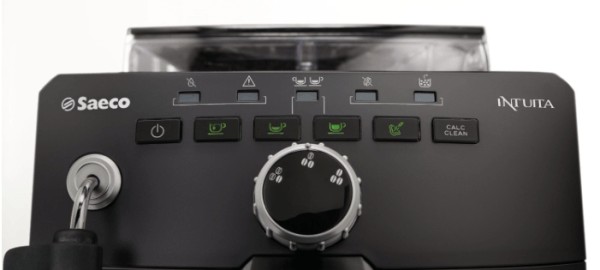Due to the wide range of automatic espresso machines offered by the Saeco brand, we have dared to make a joint presentation of all of them and comment on their main virtues and differences as a comparison. We think that it can be handy for users who want to buy a Saeco automatic coffee machine and do not know where to start.
NOTE: Before we start, it is necessary to clarify that we do not include in this comparison semi-professional coffee machines or professional espresso machines, which are around £1000 in price (or more, in some cases).
All Saeco automatic coffee machines are top of the range, but we can establish some scales between them. We will mainly divide them according to price and age. The cheaper models in this comparison – Xsmall, Minuto and Odea Go– have been on the market longer and are priced between £250 and £300. Many of them are already out of print, so watch out.
A little further up the range, we find the Intelia and the Intuita. These are two very similar machines, which can be found in the £300-400 range, and which happen to be Saeco’s best-selling and most popular automatic coffee machine models for many years. Today they are also out of the market.
Finally, we find at the top of the home range the Moltio, Syntia and Incanto models. Any of these coffee machines are around £550-600 in price and have several features that we will not find in the rest and especially the automatic preparation of milk drinks. These top-of-the-range models are aimed at the most demanding consumer, and therefore, although they are not suitable for all pockets, they also have their share of customers.
- Philips Saeco Moltio – coffee makers
- Philips Saeco Syntia Class – Coffee Makers
- Saeco Incanto Super-automatic espresso machine HD8917/09
Similarities between Saeco automatic coffee machines
Before establishing differences in the comparison, let’s remember some of the standard features that we will find in any of the coffee machines included in this report.
All Saeco automatic coffee machines have integrated grinders and work at 15 bars of pressure. They allow us to prepare one or two coffees simultaneously, have a space for preheating the cups or glasses in which we are going to serve the coffee, and also include the essential milk frother.
They also allow us to make use of the well-known Aroma, a pre-infusion system for the coffee bean that is exclusive to Saeco and which, if possible, extracts the nuances and flavours from the bean with greater strength. They also have an automatic cleaning or rinsing system that makes maintenance much more comfortable.
However, these automatic coffee machines have several differences between them, sometimes slight, but other times very recognisable. We are going to focus on the latter, the more visible ones, to try to help you distinguish them more easily.
Basic range of Saeco automatic coffee machines: Xsmall, Minuto and Odea Go
We call them “basic range” to place them in a somewhat understandable way within the entire range of Saeco automatic coffee machines. However, this name should not be taken as a pejorative. We are talking about coffee machines that are around £300 in price and whose main distinguishing feature compared to those we will analyse later is that they have an older market launch date.
They should not be seen as old-fashioned models of coffee machines, but simply that the automatic coffee machines that Saeco manufactured later included new features or more advanced functions.
Let’s start with the Saeco Odea Go, a coffee machine with its personality, which we clearly distinguish from other Saeco machines by its modern, colourful and casual design. In addition to the traditional black and silver, the Odea Go is available in attractive vanilla shades. Besides, its control panel is different from the buttons and light panels of the other models. Almost all the operating controls of the coffee machine are compressed into one considerable central rotary control.
The Xsmall shares rounded lines with the Odea Go, although its black colour is much soberer. It is the most compact and useful of the three machines in this essential range of Saeco automatic coffee machines.
The Minuto, on the other hand, has a prism-shaped design, much more classic and less compact than the previous ones. As it is larger, it also has a larger capacity tank: 1.8 litres, a more significant waste compartment (twice as big as the Xsmall) and a larger coffee bean tank: 250 grams as opposed to 180.
The Minuto model is also more potent than the other two (1850 versus 1400 watts) and has the exclusive Saeco adaptation system, which allows the coffee maker to intelligently adapt the preparation according to the qualities of the coffee bean to be served. In the following image, you can see how it looks, much more traditional:
In short: the Odea Go is compact and casual, the Xsmall is even more compact, and the Minuto is a large automatic.
Saeco mid-range automatic coffee machines: Intelia and Intuita
Intelia and Intuita, especially the former, have traditionally been Saeco’s most popular and best-selling automatic coffee machines. For the general public, their performance is more than sufficient, and they more than meet the expectations of a sizeable automatic coffee machine. As a guide, we will say that Intelia is a slightly evolved model compared to Intuita.
Both coffee machines have a 1.5 litre capacity, fast heating boiler, ceramic grinders, and automatic cleaning systems, among other standard features.
The first difference is in the control panel: the Intelia has an informative digital display, while the Intuita has only buttons and LED indicators. In these two photographs, you can see them clearly:


Moreover, the Intelia allows the use of both coffee beans and ground coffee (the Intuita does not have an input for ground coffee) and also has an automatic decalcification cycle. At the same time, in Intuita, we must perform this operation manually.
Apart from all this, the Saeco Intelia coffee machine has some variations or alternatives in its models. In general, we will tell you that you can acquire it with or without an additional milk deposit:
- Intelia without milk tank
- Intelia with milk tank
And also in two versions: black or silver. The latter is more expensive.
In short, two very similar coffee machines with slight functional differences in favour of the Intelia (which is also slightly more expensive, as usual).
Saeco top range of automatic coffee machines: Syntia, Moltio and Incanto
The Saeco Incanto can be said to be a natural evolution of the Moltio model. Its control panel has a similar configuration, with six large push buttons and a large digital display in the centre. Its functions, water tanks (about two litres), features and sizes (dimensions, weight) are very similar and differ mainly in two details:
The Saeco Incanto includes a Cappuccinatore system, or what is the same: it allows us to prepare milk drinks – cappuccinos, lattes, sliced, stained – automatically at the touch of a button. It also has a more basic version, only with Panarello (or manual foamer).
In the Moltio, we can only prepare black coffee, and if we want to add milk or milk foam with the steamer, we have to do it manually and afterwards.
The Moltio, on the other hand, incorporates the so-called bean switch in its grinder, which is no more than a double compartment for storing different types of coffee beans. By pressing a single button, we can choose to grind the coffee from one compartment or another so that we can taste more than one variety of coffee without having to change or reload the product. It is ideal if we are several drinkers at home and we have different tastes, or we can make a custom blend grinder with the proportion we want of both varieties.
The Syntia, on the other hand, is a slightly more compact machine than the previous ones, which means that it is more manageable, but its water tank is smaller (1.2 litres), and its control panel is more straightforward. There is a version of Syntia with an additional milk tank. Therefore, it has an automatic cappuccino system (One-Touch-Cappuccino), but it is already a little more expensive than its sisters.
As a difference from the Moltio and Incanto, the Syntia includes an exclusive adaptation system patented by Saeco. In short, this device intelligently adjusts the coffee preparation to the type of bean and drink you want to prepare. There is no need for us to go through the various parameters (dose, amount of water) until we find the right setting.
As main points in common, these three coffee machines have ceramic grinders (not metal), programmable memory, and allow to select the temperature at which we want to serve the coffee.
To close this comparison, we must remember that the classification we have just presented to you is purely indicative and that it is not mathematical. For example, the advanced versions of the Intelia (such as the Intelia Evo with cappuccino system) could fit perfectly by function and by price into the block that we have called “high range” of Saeco automatic coffee machines.
We could also establish an evolutionary correlation (according to age and similarities) between the Minuto, Intuita, Intelia and Incanto models. If you look at the photographs of the four throughout this report, you will see that aesthetically they follow a similar line. Above them is the Saeco PicoBaristo, which appeared on the market back in 2015 and is a faithful successor to the goodness of the Incanto.
Philips Series 2000, 3000, 4000 and 5000
We consider it necessary and unavoidable to comment in this article on the recent Series of automatic coffee machines presented by Philips – the usual manufacturer of Saeco. Through its brand, and which are nothing more than updates or improved versions of some of the Italian firm’s most popular coffee machines.
We start with the Philips 2000 Series, an automatic coffee machine that has as an inevitable reference (in price, in qualities and even in design) in the popular Saeco Xsmall.
We continue with the Philips 3000 Series and its companion 3100 Series, which is in the medium segment of automatic machines and is inspired by models such as the Minuto or the Moltio.
On a higher level, we find the Philips 4000 Series, which improves on the previous two, although it takes the design and controls borrowed from the 3000 Series.
More recent is the Philips Series 5000, which is virtually the equivalent of the more advanced Saeco Incanto.
None of these machines features the Saeco logo, although the similarities with their predecessors are very evident, as you can see. It seems that Philips has this time decided to market them under its brand.
NOTE: Outside this analysis are the automatic coffee machines that we consider to be premium, or semi-professional, such as the Exprelia Evo, Lirika or the Royal. However, you can read their analysis on our website in case they are within your budget (usually over 1000 pounds).
Similarly, Saeco markets specific models that we consider quasi-professional espresso machines, such as the Gran Baristo, the Xelsis or the Aulika. You can see their reviews in this article: The ten best professional coffee machines for home.
In short, as you can see, the range of Saeco automatic coffee machines is extensive, and the differences between them are sometimes tricky to calibrate. We hope we have helped you.
